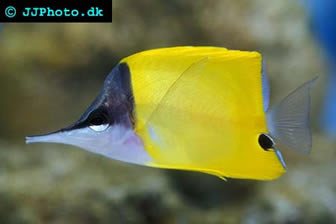Yellow Longnose Butterflyfish
Forcipiger flavissimus
The fish Forcipiger flavissimus is known under several different names in English, including Yellow Longnose Butterflyfish, Yellow Long Nose Butterfly, Common Longnose Butterflyfish, Longnose Butterflyfish, Longnose Butterfly fish, Long Nose Butterfly Fish, Long-nose Butterflyfish, Long-nosed Butterflyfish, Longnosed Butterflyfish, Longsnouted butterflyfish, Forcepsfish, and Forceps Fish.
Forcipiger flavissimus has not been evaluated for the IUCN Red List of Threatened Species.
Geographical range, habitat and habits
The Yellow Longnose Butterflyfish inhabits the Indo-Pacific and Eastern Pacific. In the Indo-Pacific, the species is found from East Africa and the Red Sea to Hawaii and the Easter Islands. Northwards, their range proceeds up to southern Japan. Southwards, they can be encountered down to Lord Howe Island of Australia and throughout Micronesia. In the Eastern Pacific, the fish can be encountered in the waters of southern Baja California, Mexico and around the islands of Revillagigedo and Galapagos.
The Yellow Longnose Butterflyfish is commonly found on exposed seaward reefs but you can also encounter it on lagoon reefs. It has been reported from fairly great depths; its depth range is 1-114 meters / 3-374 feet.
The Yellow Longnose Butterflyfish lives alone, in pairs or in small groups consisting of less than six individuals. Adult fish usually live in pairs.
Size and appearance
The largest scientifically measured Yellow Longnose Butterflyfish was 22 cm / 8.7 in.
The Yellow Longnose Butterflyfish has a bright yellow body adorned with a black eye-spot on the anal fin (close to the caudal peduncle). The head is black above and silvery-white below. Over the eye, you can see a disruptive black bar.
This fish looks similar to Forcipigerlongirostris, but Forcipiger flavissimus has a shorter snout with a bigger mouth and a higher number of dorsal spines. On Forcipiger longirostris, you can see dark-centered scales on the thorax.
Yellow Longnose Butterflyfish care
It is always important to include a lot of suitable hiding spots in the aquarium for this fish as well as open areas for swimming. Housing Yellow Longnose Butterflyfish in an aquarium smaller than 40 gallons / 150 litres is not recommended. You can keep several butterflies together if you give them at least 20 gallons / 75 litres each and decorate the aquarium well. Keeping just one butterfly per aquarium is much safer. They are generally peaceful and can be combined with other peaceful species that won’t eat them in a community aquarium. This fish will rarely eat corals.
Ideally keep the water temperature in the aquarium at 72-78 degrees F / 22-25.5 C, the specific gravity at 1.020-1.025 and the pH-value on 8.0-8.4.
If the fish isn’t comfortable in the aquarium, it can easily loose its colours. If this happens, check the water quality and watch out for bullying fishes. Maybe your Yellow Longnose needs more suitable hiding spots in the set up? It is however perfectly normal for this fish to look whitish and colourless if the lights are suddenly turned on, e.g. in the morning or when a transportation box is opened.
The Yellow Longnose Butterflyfish is known for its somewhat eccentric behaviour in the aquarium; it is for instance fond of swimming and hanging upside down in the water. It can also spit out water towards your at the surface, like a tiny fountain.
Feeding Yellow Longnose Butterflyfish
In the wild, the Yellow Longnose Butterflyfish feeds on a variety of animals. It is especially fond of polychaete tentacles, the tube feet of echinoderms, and the pedicellaria (the jaw like structure) of sea urchins. It will also eat small crustaceans, hydroids, and fish eggs.
In the aquarium, the Yellow Longnose Butterflyfish is not a fussy eater, especially not compared to many other butterflyfishes. Keep it on a varied meaty diet, e.g. worms, shrimps, clams and similar. It will normally accept not only live food but fresh, frozen and dry food as well.
Breeding Yellow Longnose Butterflyfish
This is an egg-laying species that forms pairs during breeding.
Butterflyfish Articles:
Copperbanded Butterflyfish – Chelmon rostratus
Golden Butterflyfish – Chaetodon semilarvatus
Klien's Butterflyfish – Chaetodon kleinii
Lined Butterflyfish – Chaetodon lineolatus
Longfin Bannerfish – Heniochus acuminatus
Raccoon Butterflyfish – Chaetodon lunula
Saddleback Butterflyfish – Chaetodon falcula
Schooling Bannerfish – Heniochus diphreutes
Threadfin Butterflyfish – Chaetodon auriga

